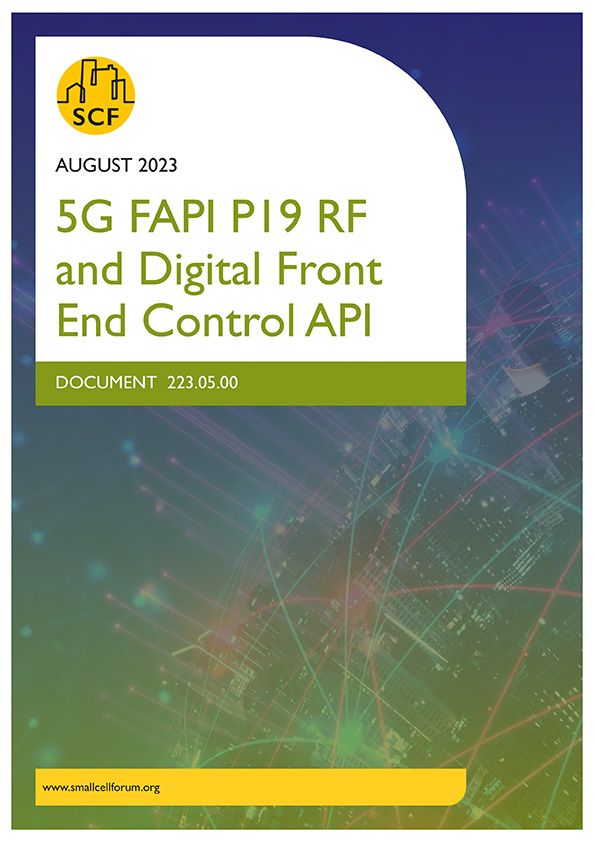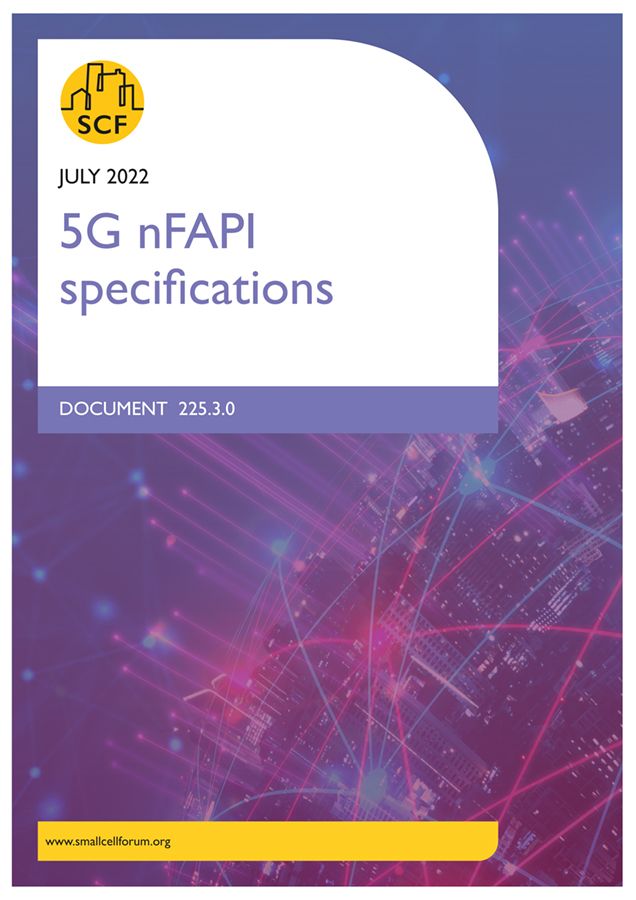SCF has published five specifications within 5G FAPI, its landmark family of common interfaces.

SCF has updated the suite of 5G FAPI specifications which underpin the high-performance low-cost components integral to 5G mobile base stations, whether small cell or macro.
FAPI is a common standard agreed between chipset and component suppliers and mobile base station integrators. It is an API for hardware components implementing 3GPP physical layer functions and “software stacks” implementing higher layers.
FAPI has already been widely adopted in the vast majority of 2G, 3G and 4G system-on-a-chip based small cells and the 5G version is regularly updated to ensure it meets industry needs and aligns with 3GPP standards.
The latest V7 updates to the suite advance interoperability, improve O-RAN ALLIANCE Open Fronthaul support, ease small cell deployments and accelerate massive MIMO features.
Standardized components will help diversity supply chains and enable a proliferation of RAN providers developing small cell network products for a range of applications for small cells, macro cells, private networks and neutral hosts.
The latest FAPI specifications are the result of intensive cooperation between SCF members from across the ecosystem. They provide common logical interfaces for the main components of a 5G small cell, namely:
- ‘5G FAPI: PHY API’ – main data path (P7) and PHY mode control (P5) interface [SCF222]
- ‘5G FAPI: RF and Digital Front End Control API’ – (P19) for Frontend Unit control [SCF223]
- ‘Network Monitor Mode API’ – (P4) for 2G/3G/4G/5G [SCF224]
- ‘5G nFAPI Specification’ [SCF225]
- ‘5G FAPI Operations, Administration and Maintenance (OAM) Protocol for Inline High-PHY’ [SCF229]
Also included on this landing page is S-RU and S-DU Test Support [SCF228]. This paper is not a specification – the specification is derived from 3GPP standards – but aims to educate the reader on how split 6 products can be tested.

5G FAPI: PHY API Specification
This document provides the 5G PHY API specification for an application platform interface (API) between the MAC and PHY protocol layers within the small cell ecosystem. This functional application platform interface (FAPI) is an internal interface within an integrated or disaggregated small cell. The 5G PHY API specification defines a control interface (P5) and a user plane or data path interface (P7). This latest iteration brings the L1/L2 interface support to a fully cloudified environment; it also further advances MIMO signalling to support new architectures and macro deployments.
Download now
5G FAPI: P19 RF and Digital Frontend Control API
This P19 interface specification serves as a companion to the 5G FAPI P5/P7 specification. Besides enabling the fast, dynamic control of the FEU, one of the primary goals of P19 is to facilitate network virtualization by allowing stack and FEU solutions from different vendors to bind together easily. The concept applies to both the all-in-one small cell solutions where the upper, the lower layers and the FEU are all colocated, as well as the disaggregated solutions where they may reside at different physical locations.
Download now
5G nFAPI Specifications
The 5G network functional application platform interface (5G nFAPI) is an initiative that extends for 5G the functional split between the MAC and PHY functions that enables virtualization of the MAC function. This document defines a transportable interface for MAC-PHY 5G function application platform interface (5G-FAPI) defined for 5G small cells [SCF222]. This RAN architecture virtualization MAC function [SCF159] is also known as the Option 6 [3GPP TR 38.816, v15.0.0] architecture split.
Download now
5G FAPI: Network Monitor Mode API
The 5G FAPI Network Monitor Mode (NMM) P4 API interface configures and operates network monitoring functions within the capability of the PHY(s). The NMM specification defines the procedures, messages and structures to implement NMM functions for 5G 3GPP release 15 as well as legacy LTE, UTRAN, GERAN, NBIoT. This standalone specification is derived from the legacy Small Cell Forum nFAPI and FAPI Specification [SCF082]. The key updates are updated diagrams and additional 5G messages and structures.
Download now
5G FAPI Operations, Administration and Maintenance (OAM) Protocol for Inline High-PHY
FAPI OAM interface, brings to Open RAN fuller virtualized support of inline High-PHY implementations in O-RAN Alliance architecture. O-RAN Fronthaul M-Plane typically terminate in L2/L3, requiring the FAPI suite to convey O-RAN M-Plane content between L2/L3 and L1. This is taken care of in the new specification SCF229.
Download now
S-RU and S-DU Test Support
5G nFAPI [SCF225] adds a network transport wrapper around the 5G FAPI PHY API [SCF222] to create the split 6 interface between S-RU and S-DU small cell network units which SCF describes as Open6. This paper is not a specification. It considers how to test the disaggregated units S-RU and S-DU of the RAN.
Download nowRelated videos
You might also be interested in the following content…
5G FAPI updates
5G PHY API for Small Cells
Listen to Clare Somerville’s (5G FAPI Lead & Intel) presentation on 5G PHY API for small cells, presented at Small Cells World Summit 2019.
The innovation of PHY API
Clare Somerville talks about the history of FAPI, how it was adopted as an industry standard and the role it will play in delivering 5G.
5G-FAPI p19 Frontend Control Interface
Listen to Samel Celebi (Qualcomm) giving an overview of Small Cell Forum’s P19 Frontend Control Interface.
Network Monitor Mode (NMM) API for Small Cells
Vicky Messer of Picocom outlines the Network Monitor Mode API for Small Cells, which adds the 5G capability to the existing 4G, 3G and 2G radio environment monitoring capability.
S-RU and S-DU Test Support
Listen to the authors Vicky Messer, from Picocom and Balaji Raghothaman, from Keysight Technologies, discuss the paper, which considers how to test the disaggregated units S-RU and S-DU of the RAN.
Contributors






